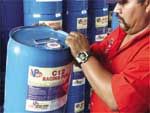
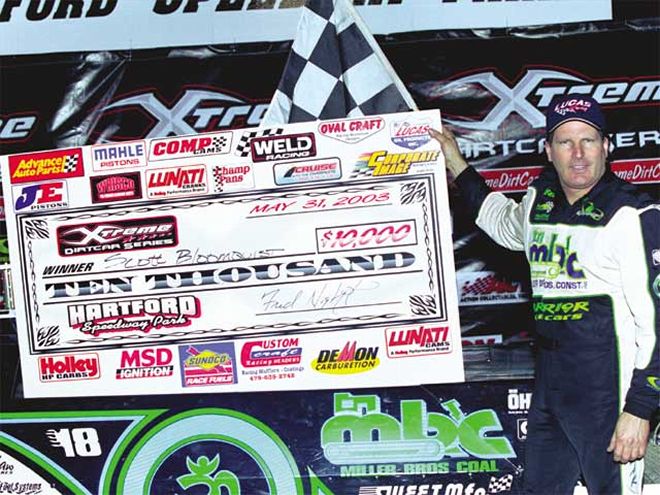 With over 400 feature wins in Late Model competition, Scott Bloomquisthas been on top of his game. Bloomquist has been using VP Late ModelPlus throughout the 2003 racing season.
With over 400 feature wins in Late Model competition, Scott Bloomquisthas been on top of his game. Bloomquist has been using VP Late ModelPlus throughout the 2003 racing season.
The heightened state of competition requires successful racers toconstantly upgrade and get the ultimate performance from every aspect oftheir program. In the minds of many, there are no huge horsepower gainsremaining. When it comes to power, the sport is speeding toward paritylike never before. Now, the challenge isn't finding 10 hp; the challengeis finding a single-unit gain in power.
The use of racing fuel is an area where the modern engine builder andracer are turning their attention. The drive for maximum efficiencybegins and ends with the fuel's performance.
Competition to provide the fuel is as heady as the on-track actionitself. Many of the major touring series do not restrict a driver'schoice, even though some of these same series have fuel companies assponsors. This freedom gives the driver a chance to work with his enginebuilder to provide the maximum power.
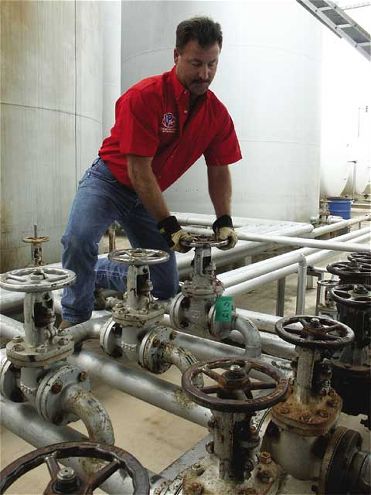 All of VP's fuel is produced at its San Antonio facility. The companyrelies on regional dealerships for distribution of fuel and otherracing-related products.
All of VP's fuel is produced at its San Antonio facility. The companyrelies on regional dealerships for distribution of fuel and otherracing-related products.
Changes in the sport have led fuel companies to be on their toes fordevelopments to enhance their products. Steve Burns of VP Racing Fuelssaid the changing demands of racing applications have been a boost forthe fuel maker.
"It has helped us because these changes make you get more and morespecific with the product," he said. "Now you're looking for a 1 or 2horsepower gain. Your fuel has to be specific for its purpose, for thetype of racing being done. You have to develop it to suit the exactneed.
"We've been doing that with drag racing and motorcycles. We've had tocome with 15 different fuels for NHRA classes. In motorcycles, the needsare so different that they give us different ways of looking at thingsand that can help development. It's like everything: The moresophisticated you can get with it, the better it's going to perform."
Doing the Job
A fuel is expected to allow for the engine to provide maximumperformance on a consistent basis. In order to do that, the variablesneed to be reduced or eliminated. Each gallon of fuel has to mirror thegallon before it with tight tolerances.
Because there are different types of engines with different demands,there are also different fuels to adjust to those demands. This is not aone-size-fits-all scenario.
"To develop a fuel, you have to essentially be a partner with an enginebuilder," Burns said. "You want the cars to be competitive when they'reout there. The fuel needs to have enough octane so there won't bedetonation."
Detonation and pre-ignition are the biggest enemies of any fuel'sperformance. The spark within the internal combustion engine needs tooccur at the right time. The perfect time is when the piston is startingits downward stroke. If the fuel ignites too late, the piston hasalready begun the process and efficiency is reduced. Ignition that's tooearly will create a force opposite of the piston force, again reducingefficiency.
In the case of detonation, the fuel becomes heated to the point ofexplosion without the needed controls. A common cause of detonationcomes from amounts of uncombusted fuel, still in liquid form, remainingafter normal ignition has taken place. When this fuel ignites, it isoften out of synch with the expected process and reduces efficiency. Bytheir nature, racing engines can be highly susceptible to detonation, aconstant concern of engine builders and fuel manufacturers.
Properties
Most fuels are known for their octane number, a point to be discussed inmore detail in short order. There are additional considerations in fueldevelopment that must be met in order for the product to make it tomarket.
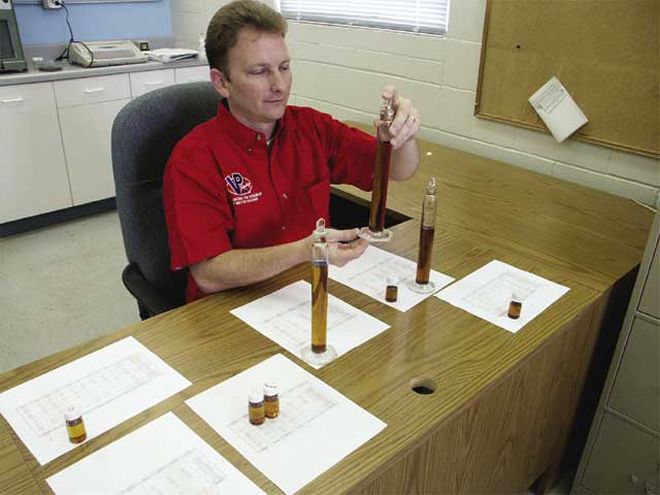 VP Chemist Duane Minazzi conducts a test of a product. These tests aredeveloped in-house to ensure fuels are made according to the properformula. The tests are performed on established fuels as well as newproduct lines.
VP Chemist Duane Minazzi conducts a test of a product. These tests aredeveloped in-house to ensure fuels are made according to the properformula. The tests are performed on established fuels as well as newproduct lines.
A figure sought by engine builders is the burning speed of the fuel.This is the time it takes for the fuel to totally release its availableenergy. If the fuel is still burning after the peak cylinder pressurehas been attained, that fuel is not contributing total efficiency.
"Gasoline does not burn, it vapor-burns. It's a liquid but it must beconverted to vapor before ignition," said Burns. "The vaporization helpsthe fuel release its energy. The gasoline goes through the intake trackand never vaporizes. You want the engine to suck in air and the fuelvapor will displace the air. The fuel is vaporizing fast as the pistoncomes up. Before you set the torch to it, you want it to be vaporized.You have to get the fuel to release the energy and you should have thatat 17 to 22 degrees after top dead center. You have to be careful thatit doesn't vaporize so quickly that you lose volumetric efficiency andpower. Burn speed is an important consideration."
Another fuel test comes from the energy value; a measure of the fuel'spotential. It is measured against the oxygen consumed in the process.It's a delicate balance because there are materials that will enhancethe fuel's energy value, but something has to give, and it is often thefuel's octane number. "It's a trade-off," said Burns about energy value."If you want one thing to go up, something will have to come down."
A final consideration is the cooling effect, directly related to theheat of vaporization. The cooling effect on the intake mixture is betterif there is a higher heat of vaporization.
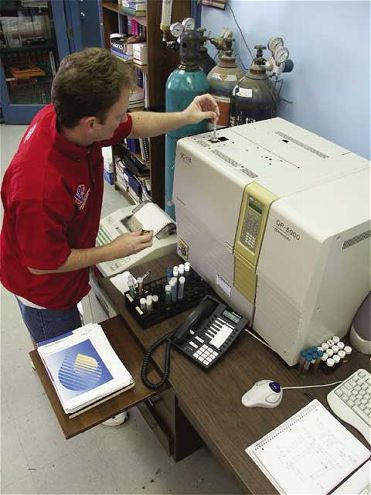 Minazzi uses a gas chromatograph/ mass spectrometer to analyze fuelcomposition for quality assurance and control. Blending, leading, anddyeing are done at the Texas location.
Minazzi uses a gas chromatograph/ mass spectrometer to analyze fuelcomposition for quality assurance and control. Blending, leading, anddyeing are done at the Texas location.
Cooling effect is seen as one of the advantages of the fuel. Dirt LateModel racer Scott Bloomquist switched to VP's Late Model Plus fuel inearly 2003. "The cooling effect allows us to run at lower enginetemperatures," Bloomquist remarked. "That's important because ourengines have high compression, a lot of power, and we operate real closeto the edge. It's more forgiving under extreme conditions and gives us agreater safety blanket against detonation."
The Octane Debate
Octane numbers are common knowledge, but there are more numbers thanthose seen on the yellow stickers on the gas pump. The common octanenumber is the product of two designations and is actually the average ofthese two numbers.
Octane is the term given to a fuel's ability to resist detonation. Thenumbers are derived from standard testing. A Research Octane Number anda Motor Octane Number are added, then divided by two to give consumersof gasoline for everyday driving a measurement of fuel performance withrespect to detonation.
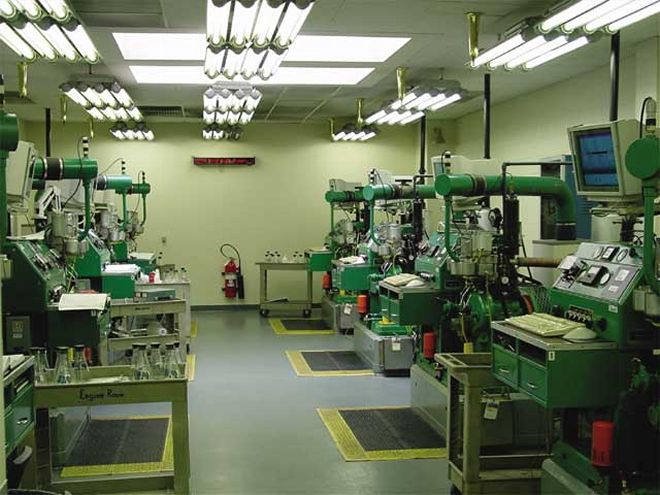 The Octane Engine Laboratory allows VP to find the correct Motor OctaneNumber for the fuel. VP uses the Motor Octane Number, which differs fromboth the Research Octane Number used by some companies and the octanenumbers seen on gasoline pumps for passenger vehicles. The Motor OctaneNumber provides a better indication of a fuel's performance in a racingapplication.
The Octane Engine Laboratory allows VP to find the correct Motor OctaneNumber for the fuel. VP uses the Motor Octane Number, which differs fromboth the Research Octane Number used by some companies and the octanenumbers seen on gasoline pumps for passenger vehicles. The Motor OctaneNumber provides a better indication of a fuel's performance in a racingapplication.
"We look at the Motor Octane Number," said Burns. "The Research Octanetest is one used to simulate cruising, which isn't what race engines arebuilt for. Race cars understand the Motor Octane Number better."
Burns added that some companies will sell their products based on theResearch Octane Number, which is generally the higher of the twonumbers.
An important consideration of an octane number is how it relates to yourengine. Once you arrive at the octane number that will prevent yourengine from detonation, there is no need to deviate. A higher octanenumber will not increase performance.
Unleaded Fuels
Most of the oval track world continues to use leaded racing fuels. Aperson new to the sport might wonder how that can happen. In the samesense, they may wonder how long it will stay that way.
Burns was asked if unleaded racing fuels, which do exist in some formsof the sport, are the future of oval track racing. It's a yes or nosituation.
"It's yes in some ways because people think it's coming and has tohappen," said Burns. "But, think about this. Airplanes are designed torun leaded fuels and there's no move to get planes to run unleaded.Leaded fuels provide a bigger window against detonation and pre-ignitionproblems. We're running carburetors on many of the engines being used inracing. It isn't the sophisticated systems that carmakers have beenbuilding. Unleaded fuels are good for those applications, but they'renot good for carburetors and the types of engines we're running in ovaltrack racing.
"The Clean Air Act gives race cars a fuel exemption. We can build racingcars to use leaded fuels because it's not covered. The engines used inclosed-course applications are treated differently.
"There doesn't have to be a change in the regulations. Airplanes arebuilt to fly with leaded fuels and you can't change planes overnight. Itwould take years. Why spend money on something that's not broken?"
Also, the sport is in no hurry to bring about the change. In the past,issues such as noise suppression have been addressed in anticipation ofpending government involvement. The sport is not likely to voluntarilylook into the idea of unleaded racing fuels. Canada, though, hasmandated unleaded racing fuel as of last December.
Fuel Enemy
Time and sunlight rank as the biggest enemies to a racer's fuel supply.Gasoline has a limited shelf life, so it's important to give it propercare.
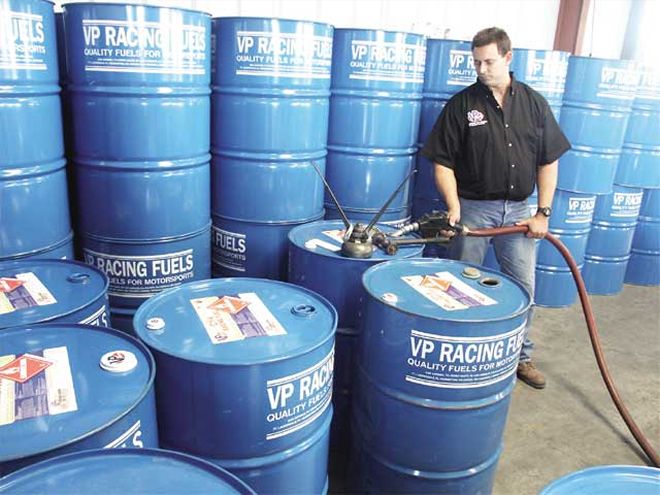 The barrels of fuel are filled and tightly sealed for their tripthroughout the United States or around the world. Users need to makesure the barrels are resealed after use to prolong the life of theproduct.
The barrels of fuel are filled and tightly sealed for their tripthroughout the United States or around the world. Users need to makesure the barrels are resealed after use to prolong the life of theproduct.
"Don't let ultraviolet rays hit the fuel," said Burns. "It will causethe lead to fall out of the composition. Take some fuel, put it in ajar, and set it in a window. You'll see how quickly the lead separatesfrom the fuel."
For that reason, storing fuel in clear containers is never a good idea.Many racing product suppliers sell plastic fuel jugs, usually red orsome other opaque color, for storing fuel.
Keeping the fuel fresh also requires using it soon after you acquire it.You cannot expect the fuel you purchased at the beginning of the year tohave the same efficiency at the end of the year. The lighter elements ofthe composition will be gone by the time you get around to using it. Thebest teams calculate fuel usage and buy accordingly. Fuel should also bekept in sealed containers for obvious reasons and stored in areas notsusceptible to moisture. Like the UV rays, temperature can be harmful toa fuel's efficiency, so a cool storage area is helpful.
Color
Like most fuel manufacturers, the products offered by VP are availablein different colors. The color has nothing to do with the performancecapability. "We dye it," Burns said. "It takes one pint of dye for every25,000 gallons. It was the surgeon general's idea some time ago. Now, itjust helps identify it. You can tell a fuel by its color and smell, andthe smell will change at different temperatures."
Matching Application
The fuel supplier and engine builder work together in productdevelopment, and that partnership extends all the way to the track. "Thefuel supplier needs to know everything, like how hot or cold the carruns, the rpm range that's expected, and so on. The things thatdetermine vaporization of fuel need to be addressed to make the carperform," said Burns.
Racers looking for the best performance need to know that the fuelsupplier and engine builder are on his side. After all, their productsare being put to the test the instant the driver turns on the engine.